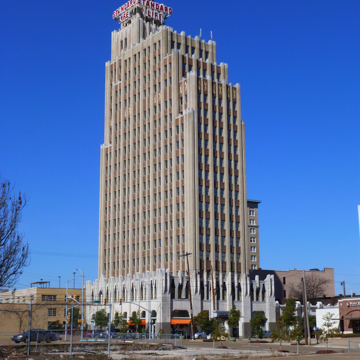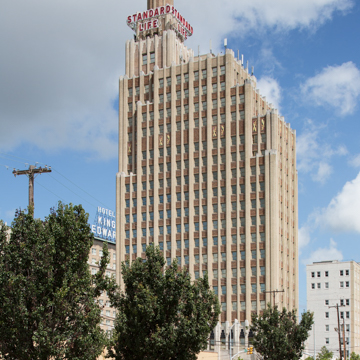You are here
Standard Life Building
In the twenty-two-story, 250-feet, concrete-framed Tower Building, Lindsley, working with Memphis engineers Gardner and Howe, captured the Lamar Life's verticality, with setbacks and colorful and textured Art Deco ornamentation. His coffered first-floor hallway sets a Mississippi high point in Art Deco opulence. Claude H. Lindsley (1894–1969) had no formal architectural education. Born in Lincoln County, Mississippi, he began working for McComb architect X. A. Kramer in 1914, and in 1920 he achieved partnership. In 1923, he opened his own office.
The Tower Building’s owners struggled to fill its 50,000 feet of office space when it opened at the beginning of the Great Depression, and the property went into foreclosure. The Works Projects Administration (WPA) and Farm Security Administration (FSA) occupied several floors at the end of the 1930s, along with underwriters and small oil companies. In 1951, the Standard Life Insurance Company moved here from their previous Art Deco headquarters, the twelve-story Plaza Building (1929, 120 N. Congress Street), designed by N. W. Overstreet, and installed the now-famous lighted sign atop the tower. In 2010, the building was converted from an office building to apartments.
Also built in 1929, the eighteen-story Merchant's Bank (200 E. Capitol Street, later Deposit Guaranty Building) nudged out the Tower Building as Mississippi’s tallest by four feet. The steel-framed structure, designed by Fort Worth's Wyatt C. Hedrick, is clad in ashlar stone, and with its simple slab shape and Venetian-arcade cornice provides a counterpoint to Standard Life.
Writing Credits
If SAH Archipedia has been useful to you, please consider supporting it.
SAH Archipedia tells the story of the United States through its buildings, landscapes, and cities. This freely available resource empowers the public with authoritative knowledge that deepens their understanding and appreciation of the built environment. But the Society of Architectural Historians, which created SAH Archipedia with University of Virginia Press, needs your support to maintain the high-caliber research, writing, photography, cartography, editing, design, and programming that make SAH Archipedia a trusted online resource available to all who value the history of place, heritage tourism, and learning.






